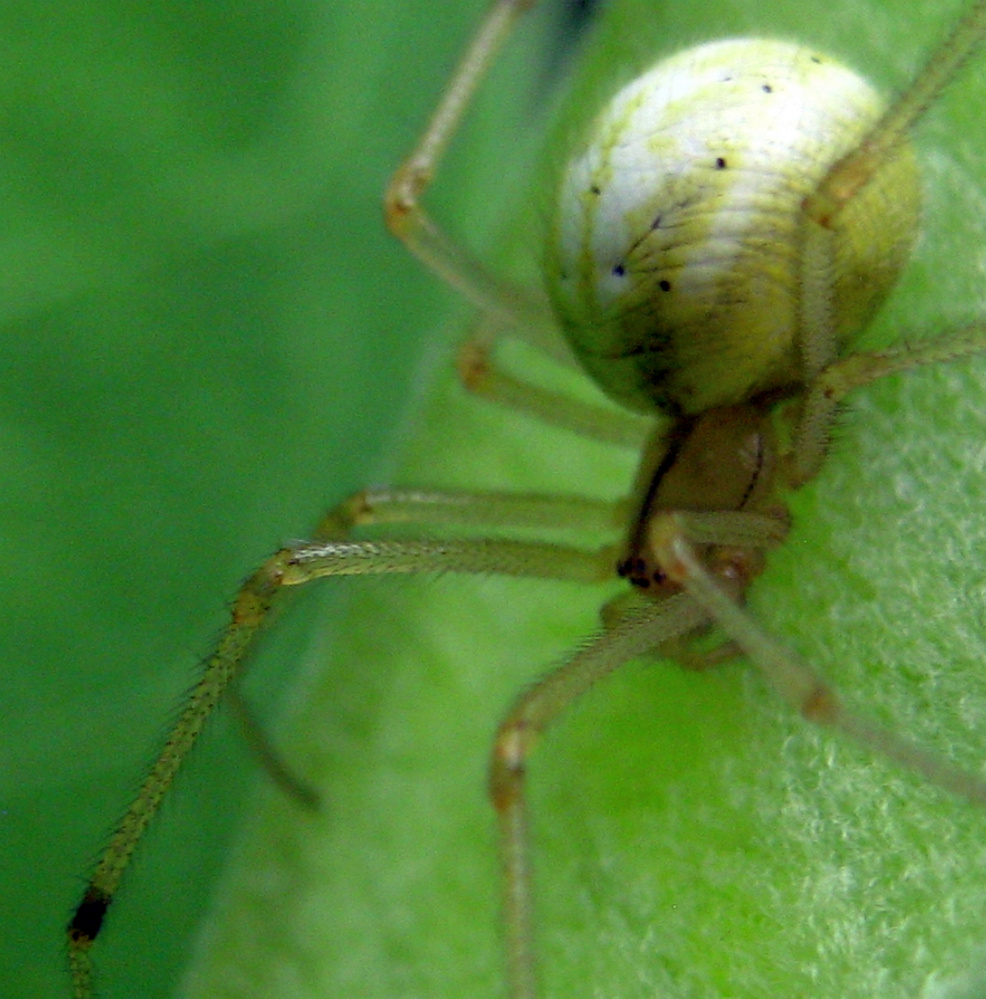Tending its cobweb in a corner of your kitchen or basement this winter, minding her own business and generally staying out of human sight, is the common house spider.
This is likely to be Parasteatoda tepidariorum, as the arachnologists call her, a member of the Theridiidae family, which are cobweb weavers. They’re also nicknamed comb-footed spiders because one of the eight legs has a row of curved bristles that the spider uses to work silk around victims caught in the cobweb. The widow spiders, who are mostly absent in Maine (though not completely — see Backyard Naturalist, July 9, 2015), are also among the thousands of species of Theridiids. One of those thousands is the curiously marked candy stripe spider, aka red and white cobweb weaver, better known to the arachnologists as Enoplognatha ovata.
I’m not sure whether it’s the actual spider or its name that’s gotten my attention lately, since like the spiders, I’m off in my own little world of winter. I’ve been repeating the phrase “Enoplognatha ovata” to myself as if it’s a song lyric. Etymologically, the ancient Greek formation Enoplognatha means, roughly, “armed jaw,” and ovata, from Latin, indicates “egg-shaped.” Theridiids in general have relatively small jaws — called in spiders chelicerae — but in E. ovata males they’re unusually large, with long fangs. Large jaws sound menacing, but they’re nothing for humans to worry about — these guys are generally less than a quarter of an inch long, and their venom, like that of virtually all spiders except a handful, has no effect on us.
Enoplognatha ovata is fairly common in Maine and North America, though it’s believed to be an invasive species introduced from Eurasia. The females build webs, which they use as retreats, underneath leaves on deciduous plants like milkweed or sometimes in maple or ash trees. By midsummer they lay eggs there and guard the sacs from inside the web until hatch time around September. A team of arachnologists who studied E. ovata on Mount Desert Island say the spiders have been known to build “colonies” of webs, but I haven’t seen this myself.
The spiderlings disperse in the fall and overwinter in leaf litter on the ground. At least one study has shown they can live through temperatures as low as minus 15 degrees Fahrenheit. When they emerge in spring, they build small webs in the curls of dead leaves; and then as they start to molt, they relocate into the live brush and trees.
The special peculiarity of E. ovata is that it’s “polymorphic” — it can have three different kinds of markings. The most common “morph,” and the one I’ve seen around here, has a pale yellow abdomen with pairs of dark spots, but no stripes; the arachnologists call this the lineata form. A second morph has two red stripes running the length of its abdomen; this is the redimita form. And the third has a solid red band down the back of its abdomen, the ovata form.
What interests the arachnologists is that, despite the much different markings, these are all the same species of spider. Populations of one morph can appear near populations of another morph, and individuals of different morphs can mate. Why are there such different appearances for the same species?
The main theory involves predator-prey relationships. One possibility is that typical predators, such as birds, who have good eyesight, may develop one image of what this particular morsel looks like — they may fix in their minds the image of the unstriped lineata morph and look for that. This way the other morphs with stripes aren’t noticed, and therefore aren’t eaten. (The scientists call this apostatic selection.)
A second possibility is sort of the inverse: The bird might pass over a spider with markings it hasn’t seen before as a matter of dietary caution. This might be effective for only a few passes, though, so the spider’s natural selective response is to generate a variety of morphs that, in a way, keep the birds guessing. Survival mechanism.
No one knows for sure if that’s what’s happening. These spiders are another morph in nature’s ways of creating variations on a theme.
Here inside the house in winter, my own mind wanders from a musical phrase to an image of a somewhat sullen, square-jawed young guitar player wearing a red-striped jacket and skinny sunglasses. His name is Eno Plognatha. He’s the front man for a polymorphic acid-rock band called Ovata struggling to distinguish itself in Los Angeles.
Just kidding. Somewhere in the medium is the message.
Dana Wilde lives in Troy. You can contact him at naturalist1@dwildepress.net. Backyard Naturalist appears the second and fourth Thursdays each month.
Copy the Story LinkSend questions/comments to the editors.




Success. Please wait for the page to reload. If the page does not reload within 5 seconds, please refresh the page.
Enter your email and password to access comments.
Hi, to comment on stories you must . This profile is in addition to your subscription and website login.
Already have a commenting profile? .
Invalid username/password.
Please check your email to confirm and complete your registration.
Only subscribers are eligible to post comments. Please subscribe or login first for digital access. Here’s why.
Use the form below to reset your password. When you've submitted your account email, we will send an email with a reset code.